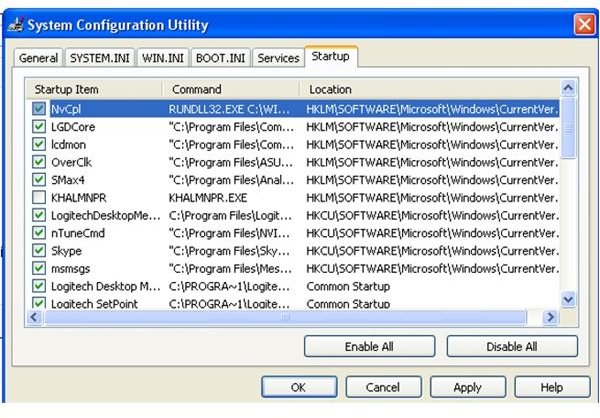Remove Startup Programs to Make your PC Run Faster
Related Articles
Computer Care Tips for Longer Computer Life
Improving Startup
The most effective method of improving the speed and functionality of you PCs startup is also the simplest. When most people finally come to me complaining about their computer being slow, their biggest complaint is typically about how long it takes for the computer to boot up. One of the number one causes of computer slow-down is unneeded programs starting themselves during the bootup process and continually running in the background. The only types of programs that you should ever need running in the background are:
- Antivirus Software
- Firewall Software
- Software that runs your peripherals, like keyboard, mouse, and printer
- Instant Messengers that you use frequently
Besides these programs, there are few, if any, that need to be constantly running in the background of your computer. There are several ways for you to stop these programs from running during bootup and staying in the background, eating up valuable computer resources. The simplest method utilizes a tool called “MSConfig”, that is usually only known of by IT professionals.
1. Click Start, then Run. If you do not see Run, then hold down the Window key and press R. This will bring up the Run input box.
2. Type “msconfig” into the Run box and then hit Enter or press OK.
3. Click on the “Startup” tab of the System Configuration Utility box.
Do not mess with any other settings outside of these instructions, as you can do a lot of damage if you don’t know what you’re doing.

- You will likely see a dozen or more entries on your Startup tab, like I have in my Screenshot. I use a lot more startup utilities than the average computer user, as I do a lot of overclocking and have specialized graphics settings. It can be difficult to determine which of these programs are useful and which are not. Some of them may even be spyware or trojan viruses.
Think of the programs on your computer that you do want to start when it boots up, like antivirus software, etc., then try to identify them in the list. The names will be abbreviated and strange. Entries that contain the letters ATI or Nv are related to video settings, and can be left checked. On mine, you will notice NvCp at the top. This is the Nvidia Control Panel for managing my detailed video settings. You may also notice LGCore and LogitechDesktopManager. Both of these are Logitech peripheral device managers for my keyboard and mouse, so I leave them checked as well. nTuneCmd is my CPU overclocking software. You will also see Skype and msmsgs (MSN Messenger), and SMax4 (SoundMax), a tool for managing my HD Audio.
It would be impossible to list all the good and bad programs that may appear in this list. If you need to, do Internet searches on some of the names you see here to find out what they are. As a general rule, things that are an incoherent jumble of letters or special characters, as well as items that appear in all capital letters, tend to be spyware programs and you should remove the check from the box next to them. You do not need things like Microsoft Office or Open Office, Instant Messengers that you do not use, or a Printer project menu to run during the boot-up process. Uncheck any of these, as well.
4. After you have unchecked all of the unwanted startup programs, click OK at the bottom of the window. A message box will pop up asking you if you want to restart your computer. Click “Restart”.
5. Once your computer reboots, you should notice that it does so much faster than before. A message will pop up letting you know that changes were made to the system configuration. Do not be alarmed. Check the box to quit displaying this message upon startup, then click OK. You have taken the first step towards speeding up your computer!
This post is part of the series: Make Your Computer Faster
Quick, easy tips to making your Windows computer run like the day you bought it. Speed up your computer with these do-it-yourself suggestions and step-by-step guides.
